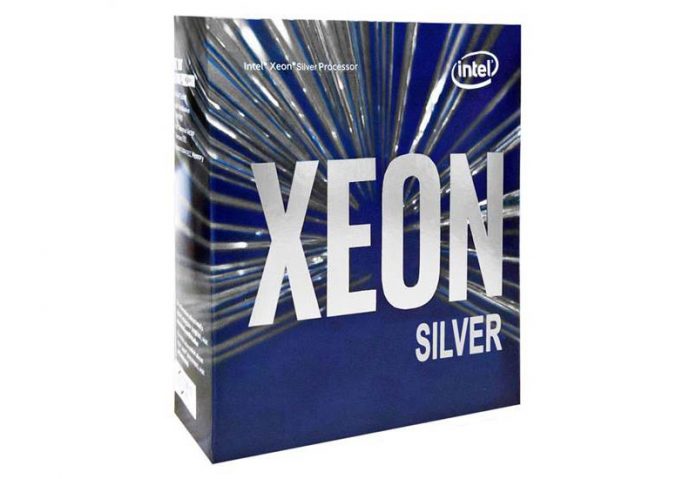At the bottom of the price range for the Intel Xeon Silver series is its second fastest CPU, the Intel Xeon Silver 4108. We already reviewed the single socket performance of the setup, now we have the dual processor benchmarks and review. If you are looking for a huge jump in performance for a nominal cost, upgrading from the Xeon Bronze 3106 to Silver 4108 is a terrific value.
At around $410 retail, the Intel Xeon Silver 4108 is one of the more intriguing values for low power servers. It is the lowest-cost eight-core Intel Xeon Scalable processor available with Hyper-Threading (16 threads.) It also holds the title of being the lowest cost CPU in the Intel Xeon Scalable processor range with Turbo Boost. With the Intel Xeon Silver 4108 there is a major step up in performance from the Intel Xeon Bronze series. As you will see in this piece, the additional features are why we recommend it for single socket systems over all but the most cost conservative servers that go for Bronze.
Key stats for the Intel Xeon Silver 4108: 8 cores / 16 threads, 1.8GHz base and 3.0GHz turbo with 11MB L3 cache. The CPU features a 85W TDP. Here is the ARK page with the feature set. The dual processor configuration we are testing today is simply two of these CPUs as you can see from the lscpu output:
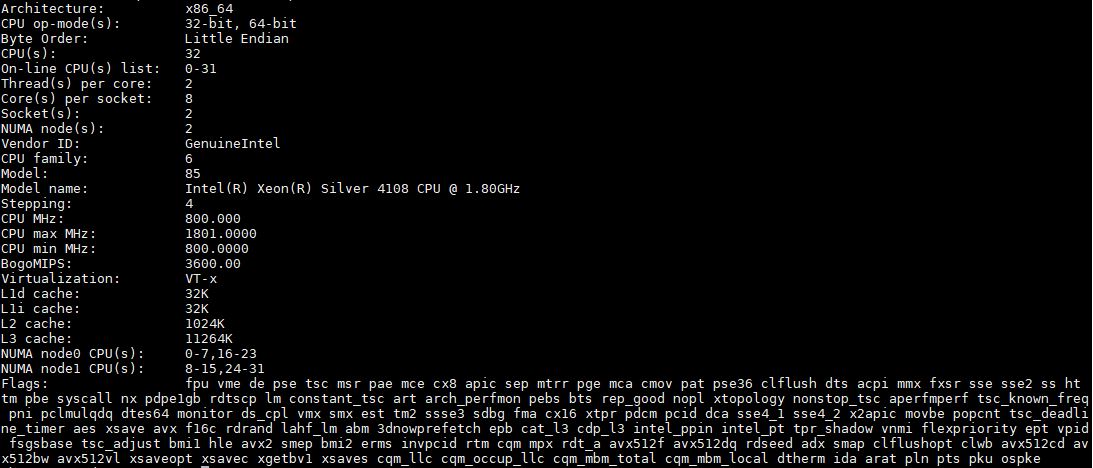
If you want to read more about the single socket performance, see our previously published Intel Xeon Silver 4108 Linux Benchmarks and Review.
Test Configuration
For this CPU review, we are using a 1U Tyan Thunder CX GT75BB7102 test platform.
- CPUs: 2x Intel Xeon Silver 4108
- System: Tyan Thunder CX GT75BB7102 1U
- RAM: 12x 16GB DDR4-2400 ECC RDIMM (Micron)
- NIC: Mellanox ConnectX-3 EN Pro 40GbE
- OS SSD: Intel DC S3700 400GB
The Tyan Thunder CX GT75BB7102 is a dual socket server that crams a surprising amount of functionality into a 1U chassis. One can put a full complement of 24x DDR4 RDIMMs along with two PCIe x16 cards, multiple OCP mezzanine cards (storage and networking) as well as use M.2 SSDs.
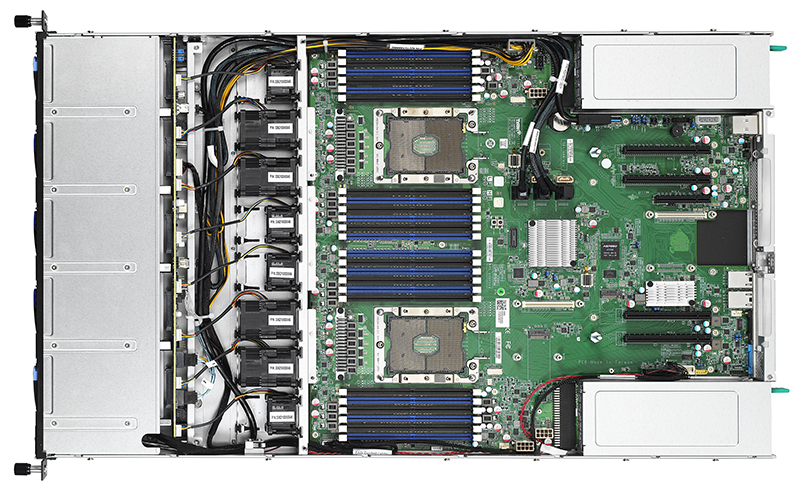
Redundant PSUs flank each side of the motherboard, and Tyan uses a novel array of fans which combine to channel cold air over the parts of the server that need it most.
In terms of storage, along with the PCIe based options, there are 10x storage bays in the front. In our test system, we are using the Intel C621 PCH SATA lanes for a low power setup. One can also use SATA DOMs on the two standard 7-pin SATA connectors.

This configuration also comes with some nice features, for example, the RJ-45 networking ports on the back of the server are 10Gbase-T Ethernet.

Overall, this is a nice platform for low power servers and we see it as a good fit for the Intel Xeon Silver 4108 setup.
Dual Processor Intel Xeon 4108 Benchmarks
For this exercise, we are using our legacy Linux-Bench scripts which help us see cross-platform “least common denominator” results we have been using for years as well as several results from our updated Linux-Bench2 scripts. At this point, our benchmarking sessions take days to run and we are generating well over a thousand data points. We are also running workloads for software companies that want to see how their software works on the latest hardware. As a result, this is a small sample of the data we are collecting and can share publicly. Our position is always that we are happy to provide some free data but we also have services to let companies run their own workloads in our lab, such as with our DemoEval service. What we do provide is an extremely controlled environment where we know every step is exactly the same and each run is done in a real-world data center, not a test bench.
Python Linux 4.4.2 Kernel Compile Benchmark
This is one of the most requested benchmarks for STH over the past few years. The task was simple, we have a standard configuration file, the Linux 4.4.2 kernel from kernel.org, and make the standard auto-generated configuration utilizing every thread in the system. We are expressing results in terms of compiles per hour to make the results easier to read.
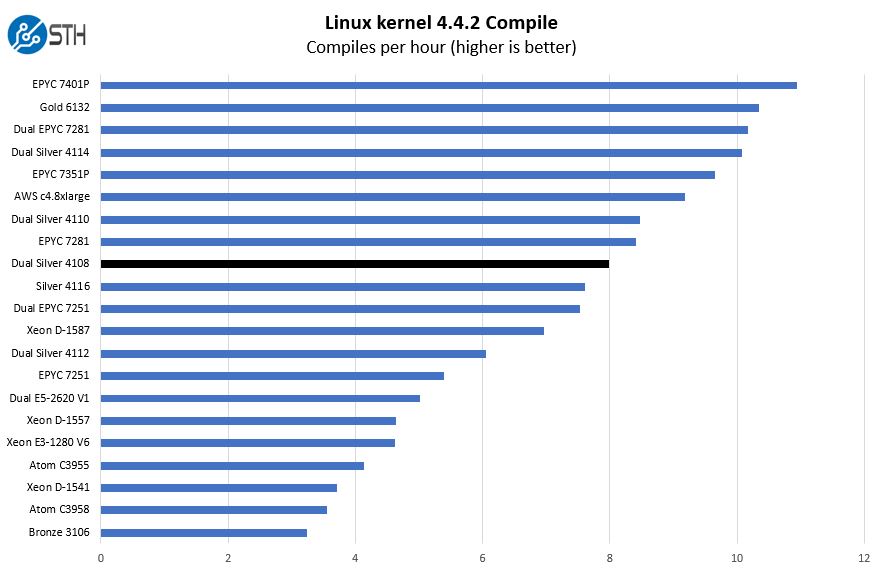
If you are looking at the dual Intel Xeon Silver v. single AMD EPYC claims that AMD makes, this is a close one between the lowest end 16-core EPYC and the lowest cost 16 core Intel configurations. In terms of operational costs, the Intel Xeon Silver is likely to cost less due to power consumption, but performance is relatively close on a well-threaded application.
c-ray 1.1 Performance
We have been using c-ray for our performance testing for years now. It is a ray tracing benchmark that is extremely popular to show differences in processors under multi-threaded workloads. We are going to use both our legacy 4K result along with our new Linux-Bench2 8K render to show differences.
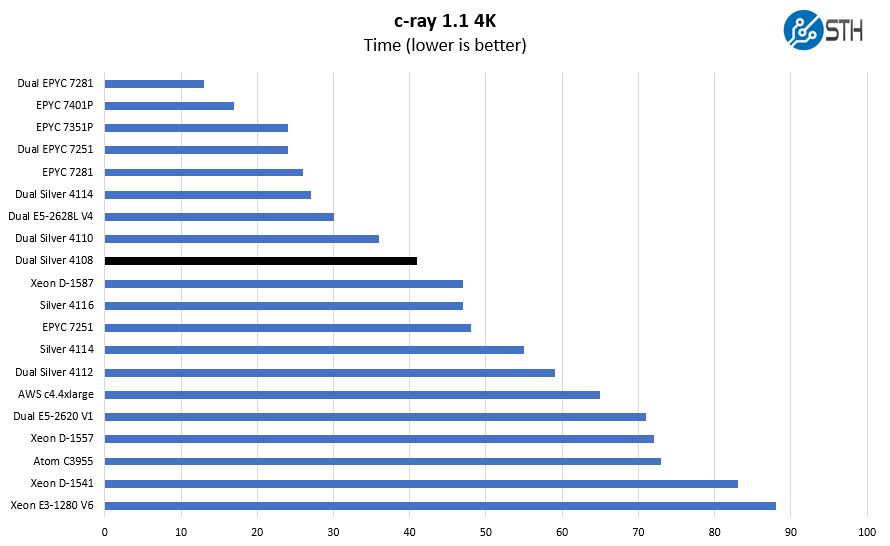
Here is a condensed set of our 8K results:
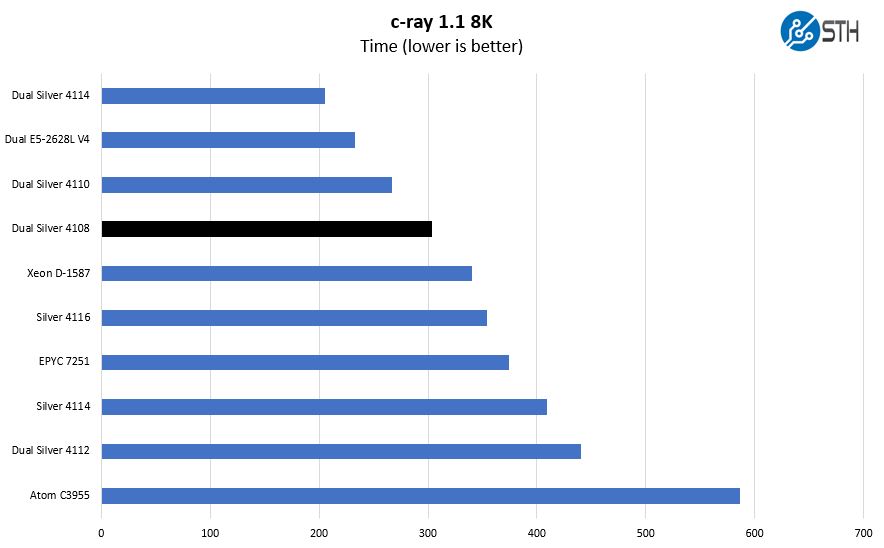
The key here is that the Intel Xeon Silver 4108 performs well beyond a single Intel Xeon Silver 4116 or dual Intel Xeon Silver 4112 CPUs.
7-zip Compression Performance
7-zip is a widely used compression/ decompression program that works cross-platform. We started using the program during our early days with Windows testing. It is now part of Linux-Bench.
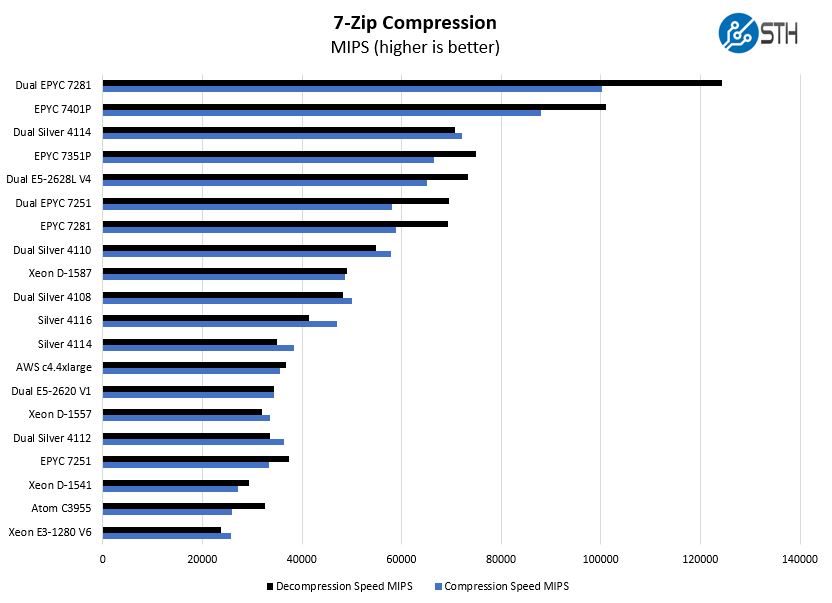
Here we wanted to point out the comparison to the AWS c4.4xlarge instance where the dual Xeon Silver 4108 configuration handily beats its cloud competition.
NAMD Performance
NAMD is a molecular modeling benchmark developed by the Theoretical and Computational Biophysics Group in the Beckman Institute for Advanced Science and Technology at the University of Illinois at Urbana-Champaign. More information on the benchmark can be found here. We are going to augment this with GROMACS in the next-generation Linux-Bench in the near future. With GROMACS we have been working hard to support Intel’s Skylake AVX-512 and AVX2 supporting AMD Zen architecture. Here are the comparison results for the legacy data set:
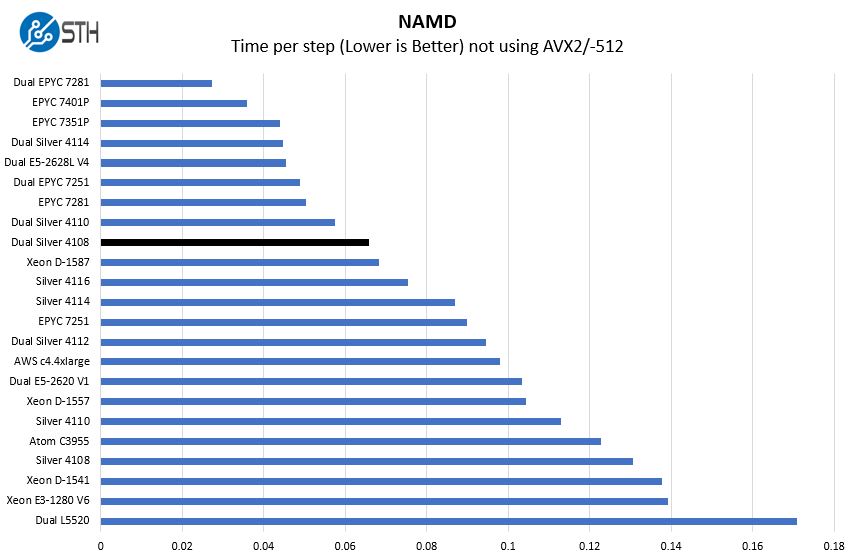
While these are good results, the Intel Xeon Silver does get some benefit from AVX-512 which we will see in our GROMACS benchmarks.
Sysbench CPU test
Sysbench is another one of those widely used Linux benchmarks. We specifically are using the CPU test, not the OLTP test that we use for some storage testing.
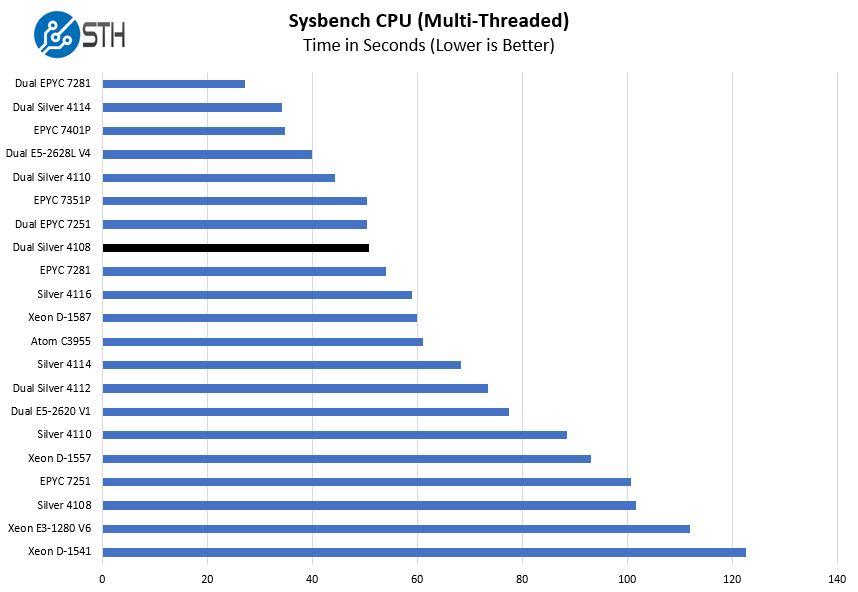
Like c-ray, this is a test where the AMD EPYC architecture is very strong. AMD is pulling even with only eight higher clocked cores.
OpenSSL Performance
OpenSSL is widely used to secure communications between servers. This is an important protocol in many server stacks. We first look at our sign tests:
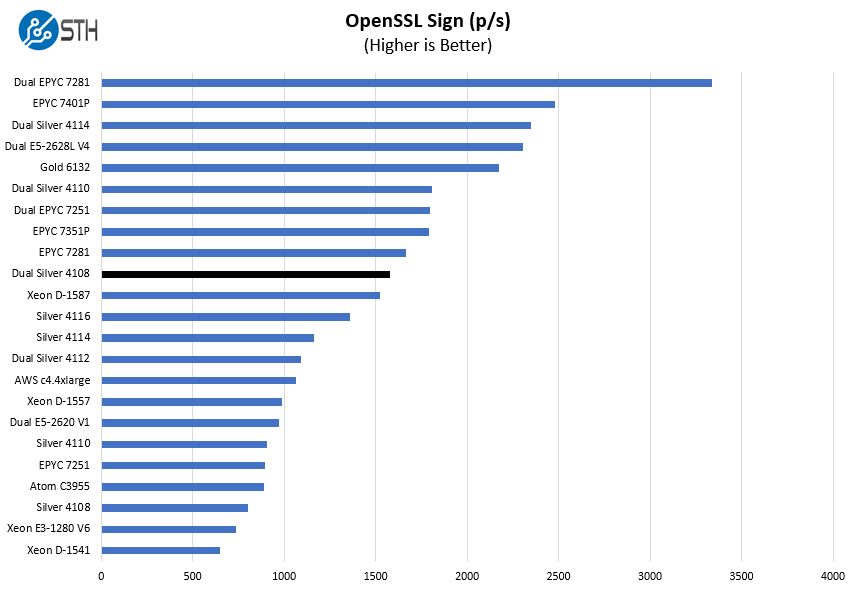
And the verify results:
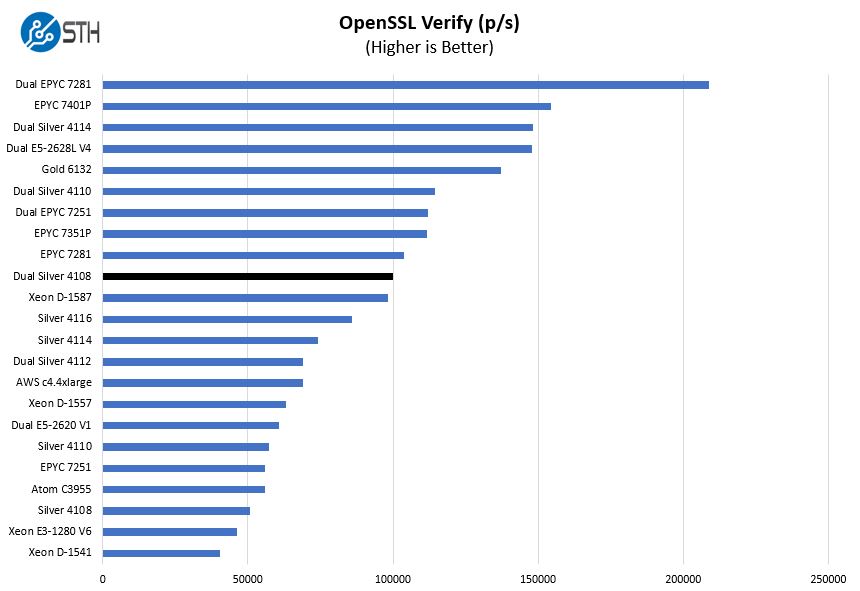
Overall results here are solid. We did want to point out that upgrading to the dual Intel Xeon Silver 4110 configuration would cost about $200, or well under 10% on the price of a server.
UnixBench Dhrystone 2 and Whetstone Benchmarks
Some of the longest-running tests at STH are the venerable UnixBench 5.1.3 Dhrystone 2 and Whetstone results. They are certainly aging, however, we constantly get requests for them, and many angry notes when we leave them out. UnixBench is widely used so we are including it in this data set. Here are the Dhrystone 2 results:
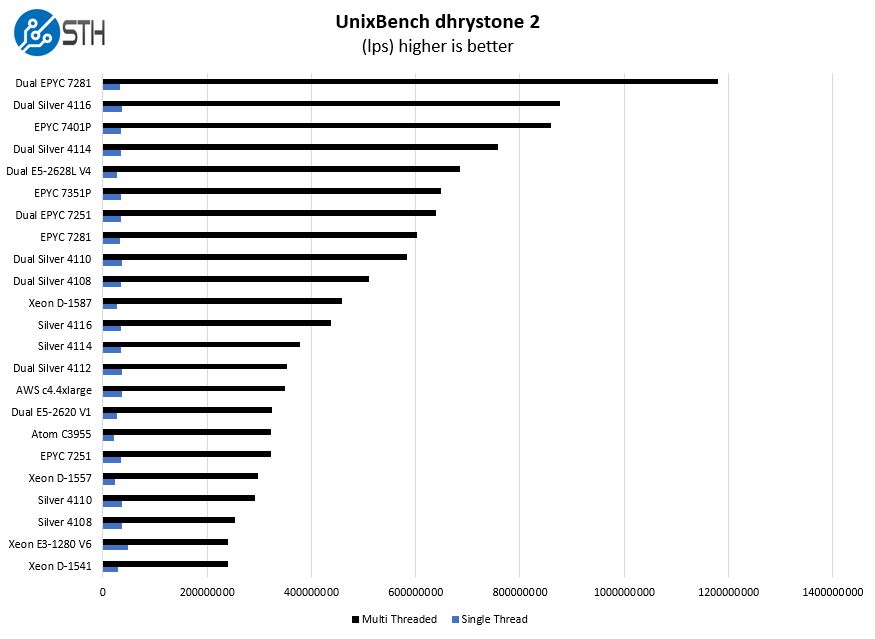
And the whetstone results:
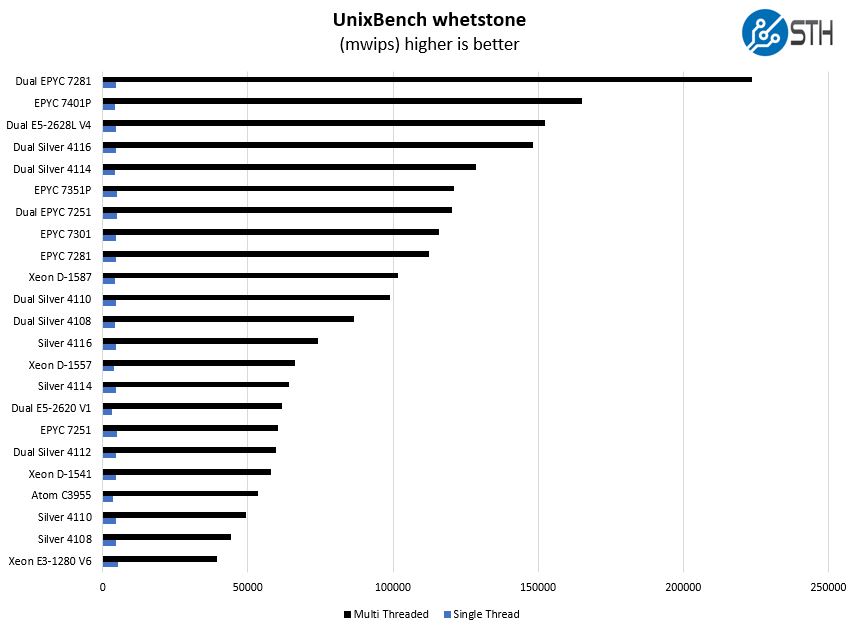
For these results, we have the entire Intel Xeon Silver line in dual processor configurations. One can see a nice scaling of performance throughout the range. Intel has strong product segmentation and many SKUs which means it can charge incrementally more for small performance boosts.
GROMACS STH Small AVX2/ AVX-512 Enabled
We have a small GROMACS molecule simulation we previewed in the first AMD EPYC 7601 Linux benchmarks piece. In Linux-Bench2 we are using a “small” test for single and dual socket capable machines. Our medium test is more appropriate for higher-end dual and quad socket machines. Our GROMACS test will use the AVX-512 and AVX2 extensions if available.
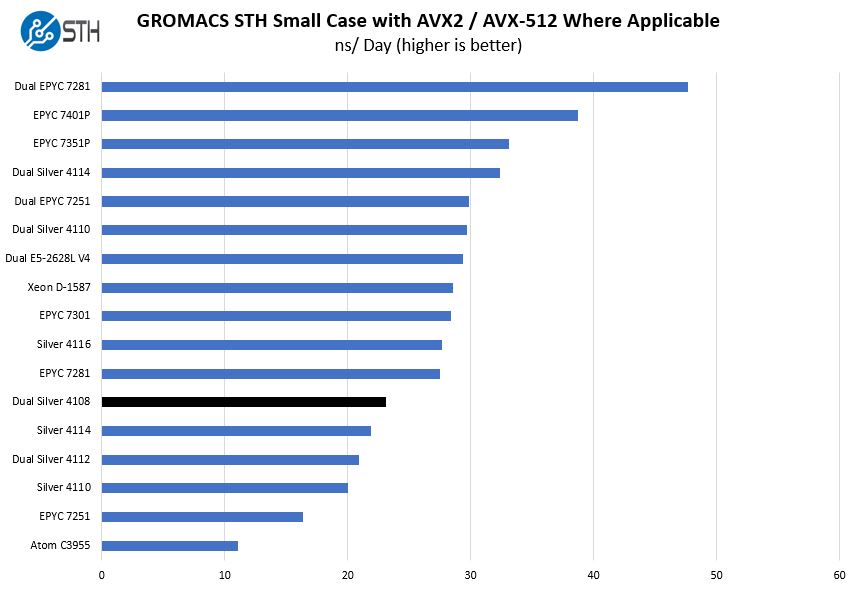
Here we can see the dual Intel Xeon Silver 4108 results are helped by the AVX-512. Unlike the Xeon Platinum and Gold 6100 series, the Intel Xeon Silver does not have access to 2400MHz DDR4 nor dual port FMA AVX-512 so these results are stunted. Just to give some perspective here, a single 8-core Xeon Gold 6134 would be the top result in this chart if we added it.
Chess Benchmarking
Chess is an interesting use case since it has almost unlimited complexity. Over the years, we have received a number of requests to bring back chess benchmarking. We have been profiling systems and are ready to start sharing results:
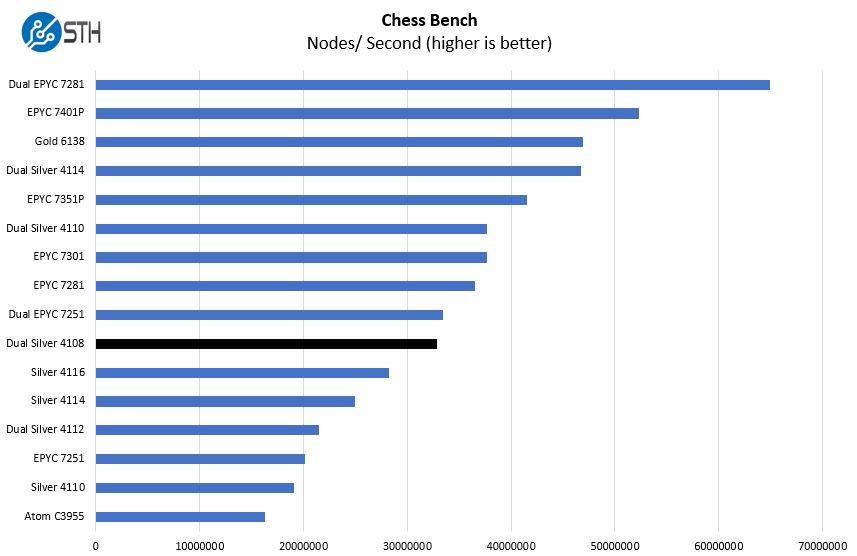
In terms of chess benchmarking, we can see that the dual Silver 4108 setup performs fairly well and close to what we see from the much higher power dual AMD EPYC 7251 setup.
A Note on Power Consumption
We wanted to post a few figures from our testing that show the real selling point of the chips, low power.
- Idle: 70W
- 70% Load: 172W
- 100% Load: 198W
- Peak: 203W
Note these results were taken using a 208V Schneider Electric / APC PDU at 17.8C and 72% RH. Our testing window shown here had a +/- 0.3C and +/- 2% RH variance. These are great power consumption figures. These are certainly solid results for this system and a large amount of the power is not used by the CPU and instead by the RAM and peripherals.
We wanted to take a pause here. This is essentially what AMD is getting from a single socket AMD EPYC 7251 even though our configuration here is using four more 16GB DIMMs or 50% more RAM which increases overall power consumption but also increases system capabilities. That is an astounding achievement. If we are looking for dual socket to dual socket 16 core configurations, dual AMD EPYC 7251’s we measured at about 100W higher power consumption under load and at peak. In our data center that is $25/ month more in operational costs. Of course, the dual EPYC 7251 configuration gets 16-32 DIMMs which is a major benefit. That brings us to market positioning.
Market Positioning
Thes chips are not released in a vacuum instead, they have competition on both the Intel and AMD sides. When you purchase a server and select a CPU, it is important to see value of a platform versus its competitors.
2P Intel Xeon Silver 4108 v. Intel Xeon
With the higher clocks of the Intel Xeon Silver 4110 only about $100 more, we see the dual socket Intel Xeon Silver 4108 targeting a market where someone wants to take advantage of a 30% performance improvement over the Intel Xeon Bronze 3106 at about $90 per chip. Unless costs pressures are extreme, we think going with the Xeon Silver 4108 over the Bronze is an easy recommendation. Features like higher clock speeds for both single and multi-threaded workloads along with Hyper-Threading are well worth the nominal price bump. If you are looking for high CPU performance, Intel has better options. Filling 12x DIMM slots with 16GB DDR4-2400 RDIMMs is a $2000+ proposition at the time of this writing so in this segment CPU costs are dwarfed by RAM, storage, server platforms and operational costs.
2P Intel Xeon Silver 4108 v. AMD EPYC
On the AMD EPYC competition side, this is one of those grey areas. First off, AMD’s lowest cost EPYC is about 15% more than a single Intel Xeon Silver 4108. While one can argue the merits of the performance of EPYC over the Intel Xeon Silver 4108, the merits of the Intel market positioning are simple. The Silver 4108 is simply a low power platform. AMD EPYC will cost less up-front, but cost more in operational costs due to power consumption.
One other area we wanted to note in single socket AMD EPYC v. dual Intel Xeon Silver 4108 is that the latter has more RAM channels and slots. While AMD touts 2TB per CPU, realistically, very few $400-800 CPUs will be paired with $50,000-80,000 of RAM. What we expect to see more of is these CPUs paired with 16GB or 32GB DIMMs which have lower cost per GB figures than 128GB LRDIMMs. In that context, the dual socket Intel Xeon Silver 4108 can have 12-24 DIMMs while a single socket AMD EPYC can use 8-16. Intel is still running at lower power consumption with 12 DIMMs versus single socket EPYC with 8 DIMMs which is truly impressive. While AMD EPYC has more PCIe lanes in single socket configurations, at this end of the market filling those PCIe lanes is like adding 2TB of RAM where it would dwarf CPU costs such that one would reflexively purchase higher-end SKUs.
Final Words
At the end of the day, if you want the lowest cost 16 cores and 32 threads in an Intel platform, the dual Intel Xeon Silver 4108 is the way to go. Realistically, if you want more performance than a Bronze offers, but want the expansion capabilities of dual socket configurations, then the dual processor Intel Xeon Silver 4108 is the configuration to go with hands-down. The eight core, low clock speed, Intel Xeon Silver 4108 CPU sips power so having two in a system has a minimal power consumption footprint. Compared to AMD EPYC, one can make a case that Intel does not have direct competition here.
One other item we wanted to address is the idea that every Intel Xeon Silver CPU has the same power consumption since they are all rated at 85W TDP is completely false. The Intel Xeon Silver 4108 sips power even in dual socket mode and we are instead seeing a lot of power draw from the 1U chassis, 12x DIMMs, Mellanox NIC and other system components. Intel’s goal was creating low power, lower performance chips that had low operational costs. With the Intel Xeon Silver 4108 the company did exactly that.

